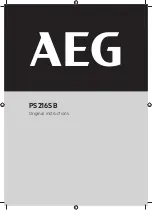
CP20VCS Issue 1 17/09/19
Original Language Version
© Jack Sealey limited
4.6.
riPPinG
4.6.1.
When ripping always use a rip fence or straight edge guide. This improves the accuracy of cut and reduces the chances of the blade
binding.
4.7.
KiCKBaCK CauSeS and relaTed warninGS
noTe:
Kickback is the sudden reaction to a pinched, bound or misaligned saw blade, causing an uncontrolled saw to lift up and out of the
workpiece toward the operator.
When the blade is pinched or bound tightly by the cut (kerf) closing down, the blade stalls and the motor reaction drives the unit rapidly
toward the operator.
If the blade becomes twisted or misaligned in the cut, the teeth at the back edge of the blade can dig into the top surface of the wood
causing the blade to climb out of the cut (kerf) and jump back toward the operator.
Kickback is the result of saw misuse and/or incorrect operating procedures and can cause the saw to jump backwards. It can be
avoided by taking proper precautions as given below.
4.7.1.
Maintain a firm grip with both hands on the saw and position your arms to resist kickback forces. Position your body to either side
of the blade but not in line with it. Kickback could cause the saw to jump backwards, but kickback forces can be controlled by the
operator, if proper precautions are taken.
4.7.2.
When the blade is binding or when interrupting a cut for any reason, release the trigger and hold the saw motionless in the material
until the blade comes to a complete stop. never attempt to remove the saw from the work or pull the saw backward while the blade is
in motion or kickback may occur. Investigate and take corrective actions to eliminate the causes of blade binding.
4.7.3.
When restarting a saw in the workpiece, centre the saw blade in the cut (kerf) and check that the saw teeth are not engaged in the
material. If the saw blade is binding, it may walk up or kickback from the workpiece as the saw is restarted.
4.7.4.
Support large panels to minimise the risk of blade pinching and kickback. large panels tend to sag under their own weight. Supports
must be placed under the panel on both sides, near the cut and near the edge of the panel.
8
do noT
use dull or damaged blades. Unsharpened or improperly set blades produce a narrow cut (kerf) causing excessive friction,
blade binding and kickback.
4.7.5.
Blade depth and bevel adjustment locking mechanisms must be tight and secure before making a cut. If blade adjustments shift while
cutting, it may cause binding or kickback.
4.7.6.
Use extra caution when sawing into existing walls or other blind areas. The protruding blade may cut objects that can cause kickback
or binding.
5. mainTenanCe
warninG!
Always ensure that the battery is removed before commencing any maintenance.
5.1.
Check the safety guard operates correctly and freely and that all screws are tightening as required.
5.2.
To prolong the useful life of the circular saw always clean it thoroughly after use and protect blade with a rust preventative.
8
do noT
clean the plastic parts with any solvents as they may attack the plastic material. Clean the saw with a dry cloth and remove
sawdust from ventilation slots.
Follow this mark with
laser for 0
o
vertical
cuts
Follow this mark with
laser for 45
o
bevel cuts
fig.4
Blade depth locking
screw
fig.3























